A New Empirical Life Prediction Model for 9–12%Cr Steels under Low Cycle Fatigue and Creep Fatigue Interaction Loadings
Abstract
:1. Introduction
2. Brief Review of the Life Prediction Models
3. Experimental Description
4. Experimental Results and Discussion
4.1. Effect of Strain Amplitude and Temperature
4.2. Effect of Hold Time and Hold Direction
5. Application of Existed Life Prediction Model
5.1. Coffin-Manson-Basquin Model
5.2. Energy Based Model
5.3. Frequency Separation Model
6. Modified MCB Model
6.1. Consideration of Effect of Temperature and Hold Condition
6.2. Material Parameters Determination and Calibration
6.3. Model Validation
7. Summary and Conclusions
Author Contributions
Funding
Conflicts of Interest
References
- Wang, R.-Z.; Zhang, X.-C.; Gong, J.-G.; Zhu, X.-M.; Tu, S.-T.; Zhang, C.-C. Creep-fatigue life prediction and interaction diagram in nickel-based GH4169 superalloy at 650 °C based on cycle-by-cycle concept. Int. J. Fatigue 2017, 97, 114–123. [Google Scholar] [CrossRef]
- Zhang, H.; Xie, D.; Yu, Y.; Yu, L. Online optimal control schemes of inlet steam temperature during startup of steam turbines considering low cycle fatigue. Energy 2016, 117, 105–115. [Google Scholar] [CrossRef]
- Jing, H.; Luo, Z.; Xu, L.; Zhao, L.; Han, Y. Low cycle fatigue behavior and microstructure evolution of a novel 9Cr–3W–3Co tempered martensitic steel at 650 °C. Mater. Sci. Eng. A 2018, 731, 394–402. [Google Scholar] [CrossRef]
- Berriche, R.; Fine, M.E.; Jeannotte, D.A. Environmental and hold time effects on fatigue of low-tin lead-based solder. Metall. Trans. A 1991, 22, 357–366. [Google Scholar] [CrossRef]
- Luo, Y.; Jiang, W.; Zhang, Y.-C.; Zhou, F.; Tu, S.-T. A new damage evolution model to estimate the creep fracture behavior of brazed joint under multiaxial stress. Int. J. Mech. Sci. 2018, 149, 178–189. [Google Scholar] [CrossRef]
- Marmy, P.; Kruml, T. Low cycle fatigue of Eurofer 97. J. Nucl. Mater. 2008, 377, 52–58. [Google Scholar] [CrossRef]
- Lee, S.Y.; Lu, Y.L.; Liaw, P.K.; Chen, L.J.; Thompson, S.A.; Blust, J.W.; Browning, P.F.; Bhattacharya, A.K.; Aurrecoechea, J.M.; Klarstrom, D.L. Hold-time effects on elevated-temperature low-cycle-fatigue and crack-propagation behaviors of HAYNES® 188 superalloy. J. Mater. Sci. 2009, 44, 2945–2956. [Google Scholar] [CrossRef]
- Srinivasan, V.S.; Nagesha, A.; Valsan, M.; Rao, K.B.S.; Mannan, S.L.; Sastry, D.H. Effect of hold-time on low cycle fatigue behaviour of nitrogen bearing 316L stainless steel. Int. J. Press. Vessel. Pip. 1999, 76, 863–870. [Google Scholar] [CrossRef]
- Gopinath, K.; Gupta, R.K.; Sahu, J.K.; Ray, P.K.; Ghosh, R.N. Designing P92 grade martensitic steel header pipes against creep–fatigue interaction loading condition: Damage micromechanisms. Mater. Des. 2015, 86, 411–420. [Google Scholar] [CrossRef]
- Wang, X.; Zhang, W.; Gong, J.; Wahab, M.A. Low cycle fatigue and creep fatigue interaction behavior of 9Cr-0.5Mo-1.8W-V-Nb heat-resistant steel at high temperature. J. Nucl. Mater. 2018, 505, 73–84. [Google Scholar] [CrossRef]
- Chauhan, A.; Hoffmann, J.; Litvinov, D.; Aktaa, J. High-temperature low-cycle fatigue behavior of a 9Cr-ODS steel: Part 1-pure fatigue, microstructure evolution and damage characteristics. Mater. Sci. Eng. A 2017, 707, 207–220. [Google Scholar] [CrossRef]
- Verma, P.; Basu, J.; Santhi Srinivas, N.C.; Singh, V. Deformation behavior of modified 9Cr–1Mo steel under low cycle fatigue at 600 °C. Mater. Charact. 2017, 131, 244–252. [Google Scholar] [CrossRef]
- Klueh, R.; Nelson, A. Ferritic/martensitic steels for next-generation reactors. J. Nucl. Mater. 2007, 371, 37–52. [Google Scholar] [CrossRef]
- Rees, D.W.A. Life prediction techniques for combined creep and fatigue. Prog. Nucl. Energy 1987, 19, 211–239. [Google Scholar] [CrossRef]
- Cui, W. A state-of-the-art review on fatigue life prediction methods for metal structures. J. Mar. Sci. Technol. 2002, 7, 43–56. [Google Scholar] [CrossRef]
- Pineau, A.; Antolovich, S.D. High temperature fatigue of nickel-base superalloys–A review with special emphasis on deformation modes and oxidation. Eng. Fail. Anal. 2009, 16, 2668–2697. [Google Scholar] [CrossRef]
- Yan, X.-L.; Zhang, X.-C.; Tu, S.-T.; Mannan, S.-L.; Xuan, F.-Z.; Lin, Y.-C. Review of creep–fatigue endurance and life prediction of 316 stainless steels. Int. J. Press. Vessel. Pip. 2015, 126–127, 17–28. [Google Scholar] [CrossRef]
- Santecchia, E.; Hamouda, A.M.S.; Musharavati, F.; Zalnezhad, E.; Cabibbo, M.; El Mehtedi, M.; Spigarelli, S. A Review on Fatigue Life Prediction Methods for Metals. Adv. Mater. Sci. Eng. 2016, 2016, 1–26. [Google Scholar] [CrossRef]
- Kamal, M.; Rahman, M.M. Advances in fatigue life modeling: A review. Renew. Sustain. Energy Rev. 2018, 82, 940–949. [Google Scholar] [CrossRef]
- Fournier, B.; Sauzay, M.; Caes, C.; Noblecourt, M.; Mottot, M.; Bougault, A.; Rabeau, V.; Pineau, A. Creep–fatigue–oxidation interactions in a 9Cr–1Mo martensitic steel. Part I: Effect of tensile holding period on fatigue lifetime. Int. J. Fatigue 2008, 30, 649–662. [Google Scholar] [CrossRef]
- Wang, R.-Z.; Zhang, X.-C.; Tu, S.-T.; Zhu, S.-P.; Zhang, C.-C. A modified strain energy density exhaustion model for creep–fatigue life prediction. Int. J. Fatigue 2016, 90, 12–22. [Google Scholar] [CrossRef]
- Yu, Z.-Y.; Zhu, S.-P.; Liu, Q.; Liu, Y. Multiaxial fatigue damage parameter and life prediction without any additional material constants. Materials 2017, 10, 923. [Google Scholar] [CrossRef] [PubMed]
- Kaae, J. High-temperature low-cycle fatigue of Alloy 800H. Int. J. Fatigue 2009, 31, 332–340. [Google Scholar] [CrossRef]
- Zerbst, U.; Ainsworth, R.A.; Beier, H.T.; Pisarski, H.; Zhang, Z.L.; Nikbin, K.; Nitschke-Pagel, T.; Münstermann, S.; Kucharczyk, P.; Klingbeil, D. Review on fracture and crack propagation in weldments–A fracture mechanics perspective. Eng. Fract. Mech. 2014, 132, 200–276. [Google Scholar] [CrossRef]
- Ainsworth, R.A.; Ruggles, M.B.; Takahashi, Y. Flaw Assessment Procedure for High-Temperature Reactor Components. J. Press. Vessel Technol. 1992, 114, 166–170. [Google Scholar] [CrossRef]
- Wen, J.-F.; Liu, Y.; Srivastava, A.; Benzerga, A.A.; Tu, S.-T.; Needleman, A. Environmentally enhanced creep crack growth by grain boundary cavitation under cyclic loading. Acta Mater. 2018, 153, 136–146. [Google Scholar] [CrossRef]
- Fournier, B.; Sauzay, M.; Caes, C.; Noblecourt, M.; Mottot, M.; Bougault, A.; Rabeau, V.; Man, J.; Gillia, O.; Lemoine, P. Creep–fatigue–oxidation interactions in a 9Cr–1Mo martensitic steel. Part III: Lifetime prediction. Int. J. Fatigue 2008, 30, 1797–1812. [Google Scholar] [CrossRef]
- Zhao, L.; Nikbin, K.M. Characterizing high temperature crack growth behaviour under mixed environmental, creep and fatigue conditions. Mater. Sci. Eng. A 2018, 728, 102–114. [Google Scholar] [CrossRef]
- Wei, Z.; Yang, F.; Lin, B.; Luo, L.; Konson, D.; Nikbin, K. Deterministic and probabilistic creep–fatigue–oxidation crack growth modeling. Probabilistic Eng. Mech. 2013, 33, 126–134. [Google Scholar] [CrossRef]
- Tu, S.T.; Zhang, X.C. Fatigue Crack Initiation Mechanisms. Ref. Modul. Mater. Sci. Mater. Eng. 2016, 1–23. [Google Scholar]
- Chaboche, J.-L. Continuous damage mechanics—A tool to describe phenomena before crack initiation. Nucl. Eng. Des. 1981, 64, 233–247. [Google Scholar] [CrossRef]
- Zhu, S.-P.; Huang, H.-Z.; He, L.-P.; Liu, Y.; Wang, Z. A generalized energy-based fatigue–creep damage parameter for life prediction of turbine disk alloys. Eng. Fract. Mech. 2012, 90, 89–100. [Google Scholar] [CrossRef]
- Chaboche, J.L. A review of some plasticity and viscoplasticity constitutive theories. Int. J. Plast. 2008, 24, 1642–1693. [Google Scholar] [CrossRef]
- Fatemi, A.; Yang, L. Cumulative fatigue damage and life prediction theories: A survey of the state of the art for homogeneous materials. Int. J. Fatigue 1998, 20, 9–34. [Google Scholar] [CrossRef]
- Fournier, B.; Sauzay, M.; Caës, C.; Noblecourt, M.; Mottot, M. Analysis of the hysteresis loops of a martensitic steel: Part I: Study of the influence of strain amplitude and temperature under pure fatigue loadings using an enhanced stress partitioning method. Mater. Sci. Eng. A 2006, 437, 183–196. [Google Scholar] [CrossRef]
- Coffin, L.F. A study of the effect of cyclic thermal stresses on a ductile metal. Trans ASME 1954, 76, 931–950. [Google Scholar]
- Manson, S.S. Fatigue: A complex subject–some simple approximation. Exp. Mech. 1965, 5, 193–226. [Google Scholar] [CrossRef]
- Fournier, B.; Dalle, F.; Sauzay, M.; Longour, J.; Salvi, M.; Caës, C.; Tournié, I.; Giroux, P.F.; Kim, S.H. Comparison of various 9–12%Cr steels under fatigue and creep-fatigue loadings at high temperature. Mater. Sci. Eng. A 2011, 528, 6934–6945. [Google Scholar] [CrossRef]
- Nagesha, A.; Valsan, M.; Kannan, R.; Bhanu Sankara Rao, K.; Mannan, S.L. Influence of temperature on the low cycle fatigue behaviour of a modified 9Cr–1Mo ferritic steel. Int. J. Fatigue 2002, 24, 1285–1293. [Google Scholar] [CrossRef]
- Basquin, O.H. The exponential law of endurance tests. Proc. Am. Soc. Test. Mater. 1910, 10, 625–630. [Google Scholar]
- Shankar, V.; Mariappan, K.; Sandhya, R.; Laha, K.; Bhaduri, A.K. Long term creep-fatigue interaction studies on India-specific reduced activation ferritic-martensitic (IN-RAFM) steel. Int. J. Fatigue 2017, 98, 259–268. [Google Scholar] [CrossRef]
- Ellyin, F.; Kujawski, D. Plastic Strain Energy in Fatigue Failure. J. Press. Vessel Technol. 1984, 106, 342–347. [Google Scholar] [CrossRef]
- Kanchanomai, C.; Mutoh, Y. Low-cycle fatigue prediction model for Pb-free solder 96.5Sn-3.5Ag. J. Electron. Mater. 2004, 33, 329–333. [Google Scholar] [CrossRef]
- Morrow, J.D. Cyclic plastic strain energy and the fatigue of metals. In Internal Friction, Damping, and Cyclic Plasticity; ASTM STP 378 American Society for Testing and Materials: Philadelphia, PA, USA, 1965; pp. 45–84. [Google Scholar]
- Coffin, L.F. Concept of Frequency Separation in Life Prediction for Time-Dependent Fatigue; General Electric Co.: Schenectady, NY, USA, 1976. [Google Scholar]
- Samantaray, D.; Mandal, S.; Bhaduri, A.K. A comparative study on Johnson Cook, modified Zerilli–Armstrong and Arrhenius-type constitutive models to predict elevated temperature flow behaviour in modified 9 Cr–1 Mo steel. Comput. Mater. Sci. 2009, 47, 568–576. [Google Scholar] [CrossRef]
- Führer, U.; Aktaa, J. Modeling the cyclic softening and lifetime of ferritic-martensitic steels under creep-fatigue loading. Int. J. Mech. Sci. 2018, 136, 460–474. [Google Scholar] [CrossRef]
- Guguloth, K.; Sivaprasad, S.; Chakrabarti, D.; Tarafder, S. Low-cyclic fatigue behavior of modified 9Cr–1Mo steel at elevated temperature. Mater. Sci. Eng. A 2014, 604, 196–206. [Google Scholar] [CrossRef]
- Zhang, S.-L.; Xuan, F.-Z. Interaction of cyclic softening and stress relaxation of 9–12% Cr steel under strain-controlled fatigue-creep condition: Experimental and modeling. Int. J. Plast. 2017, 98, 45–64. [Google Scholar] [CrossRef]
- Saad, A.A. Cyclic Plasticity and Creep of Power Plant Materials; University of Nottingham: Nottingham, UK, 2012. [Google Scholar]
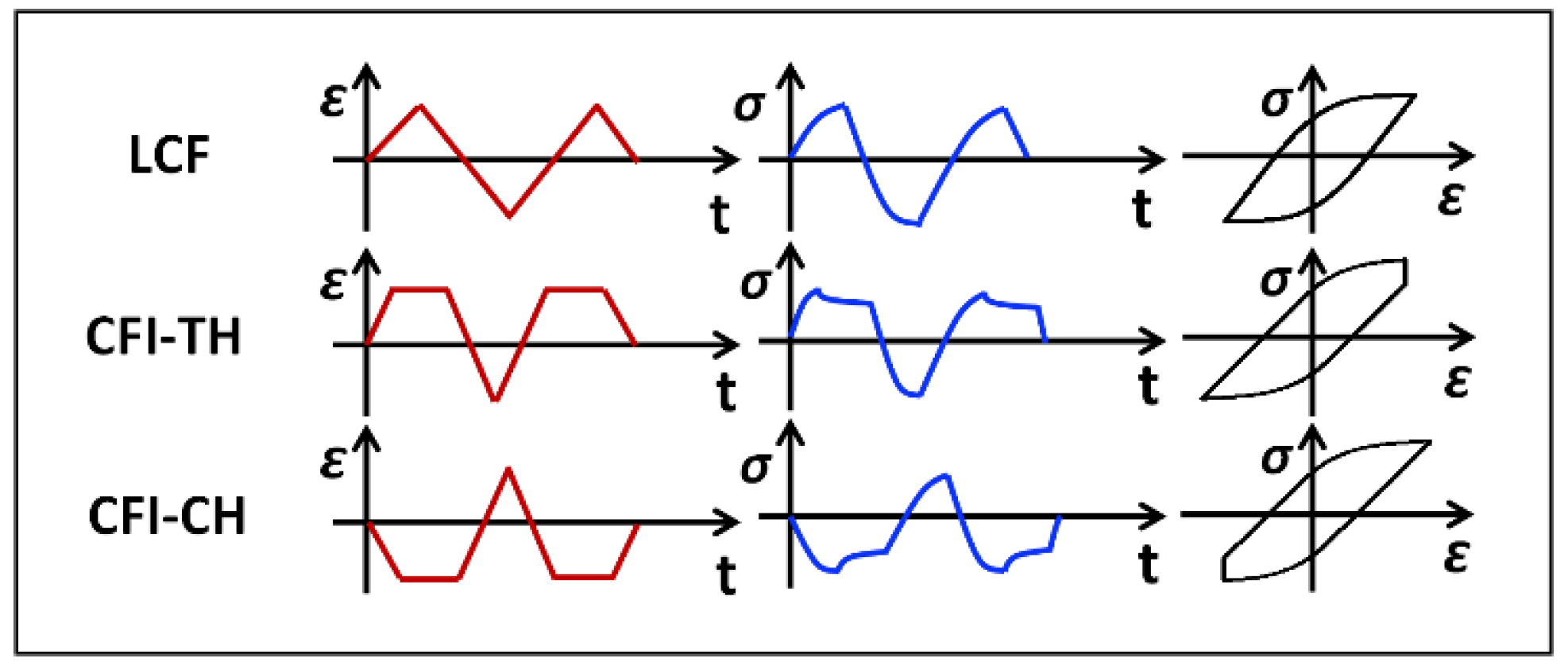
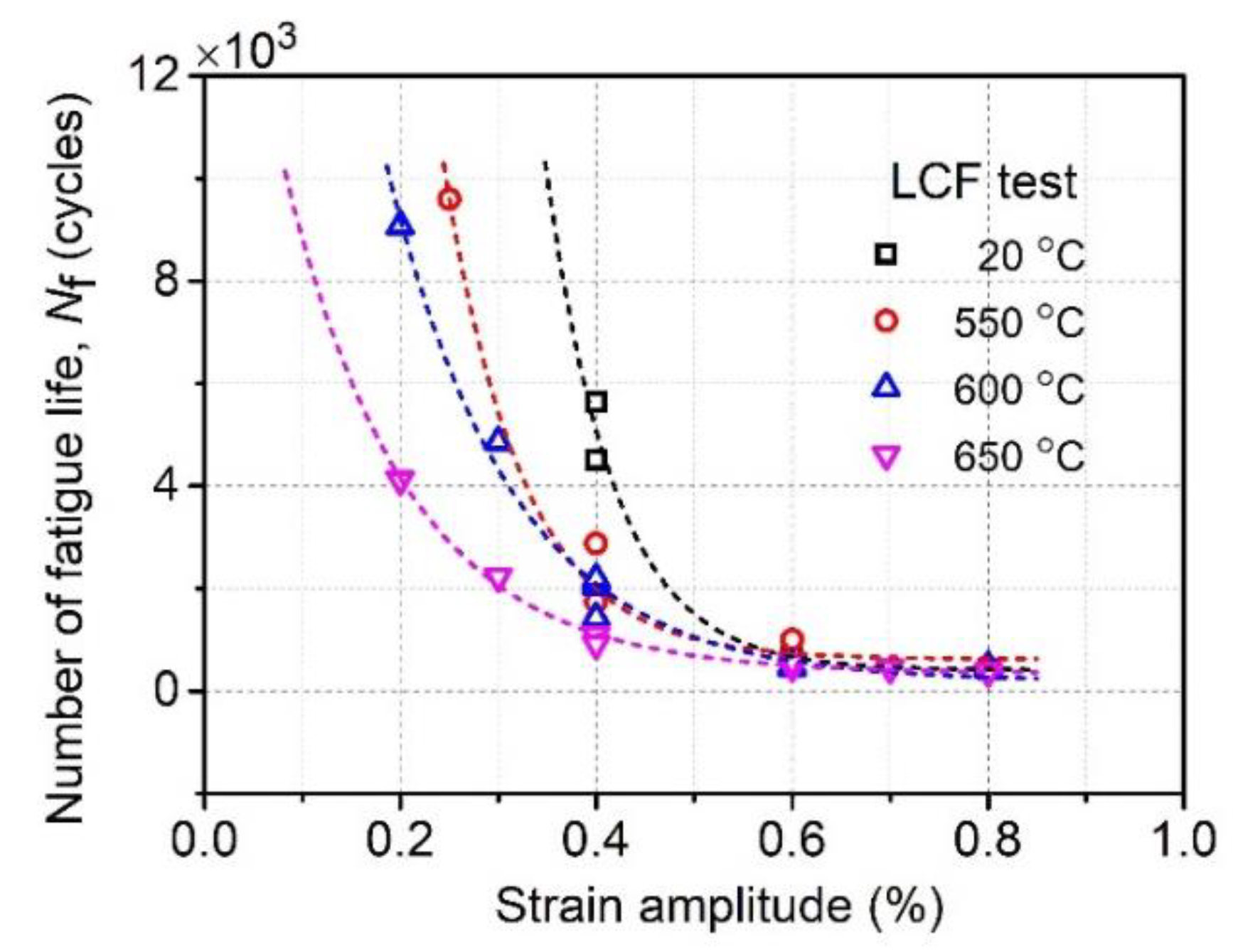
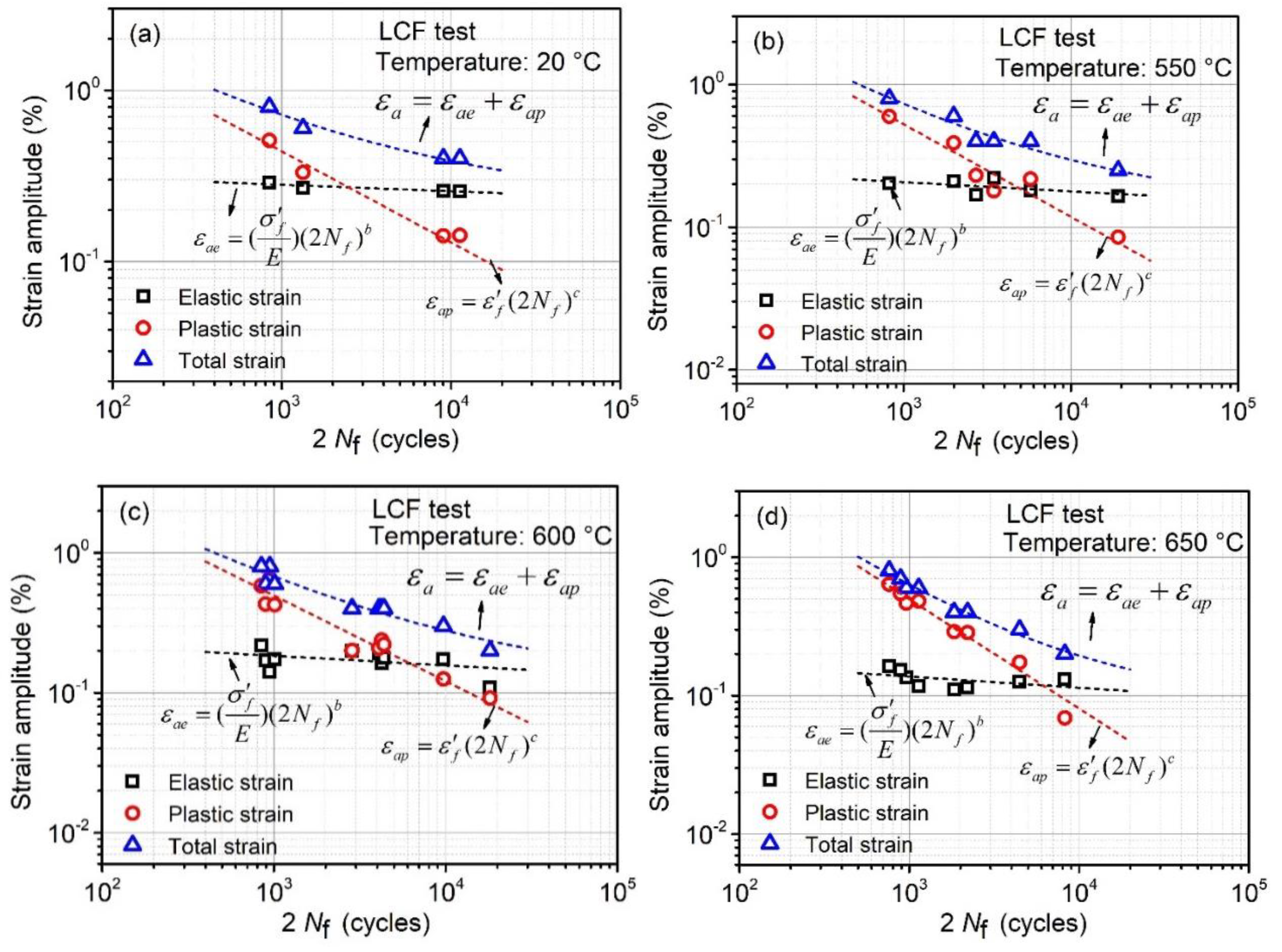
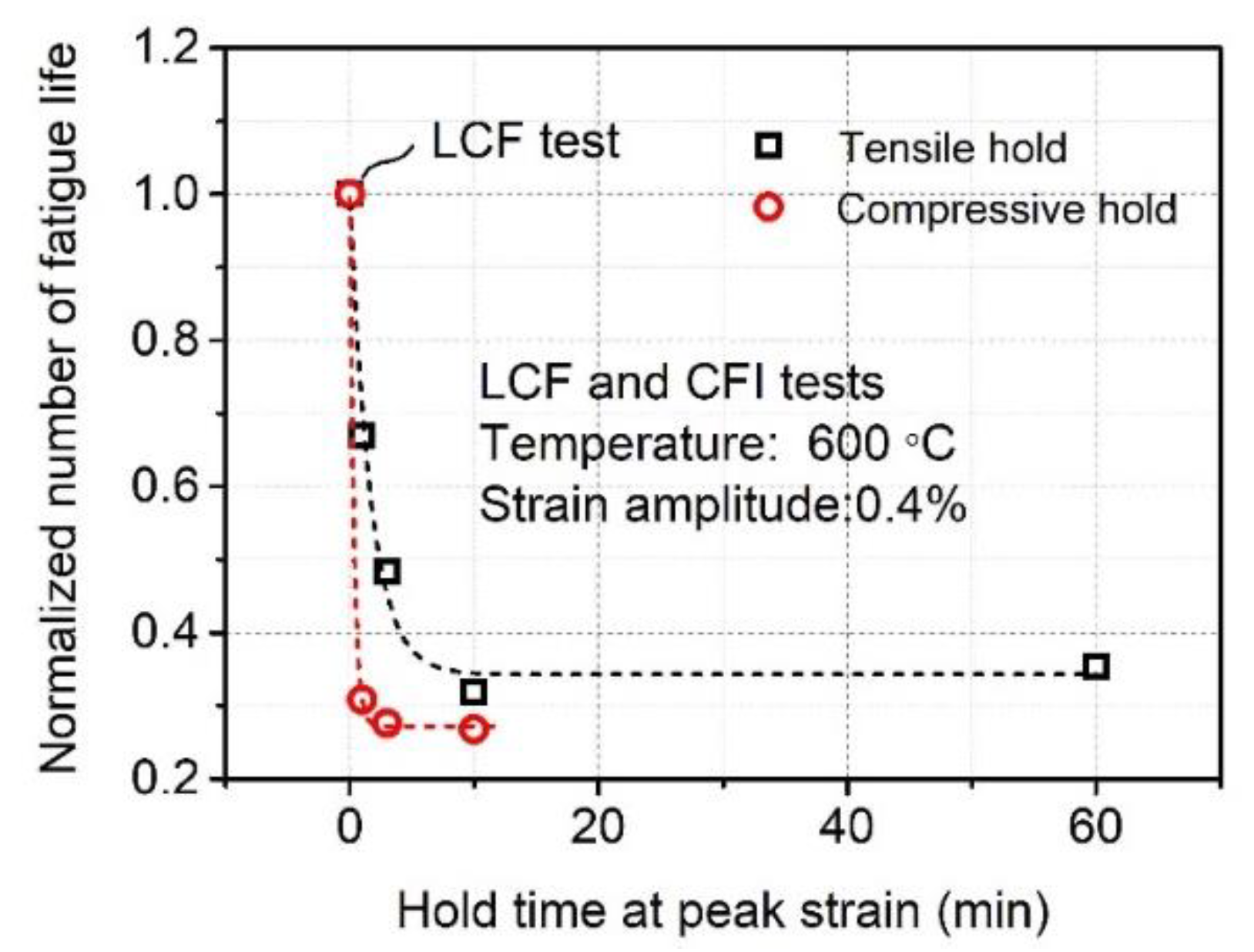
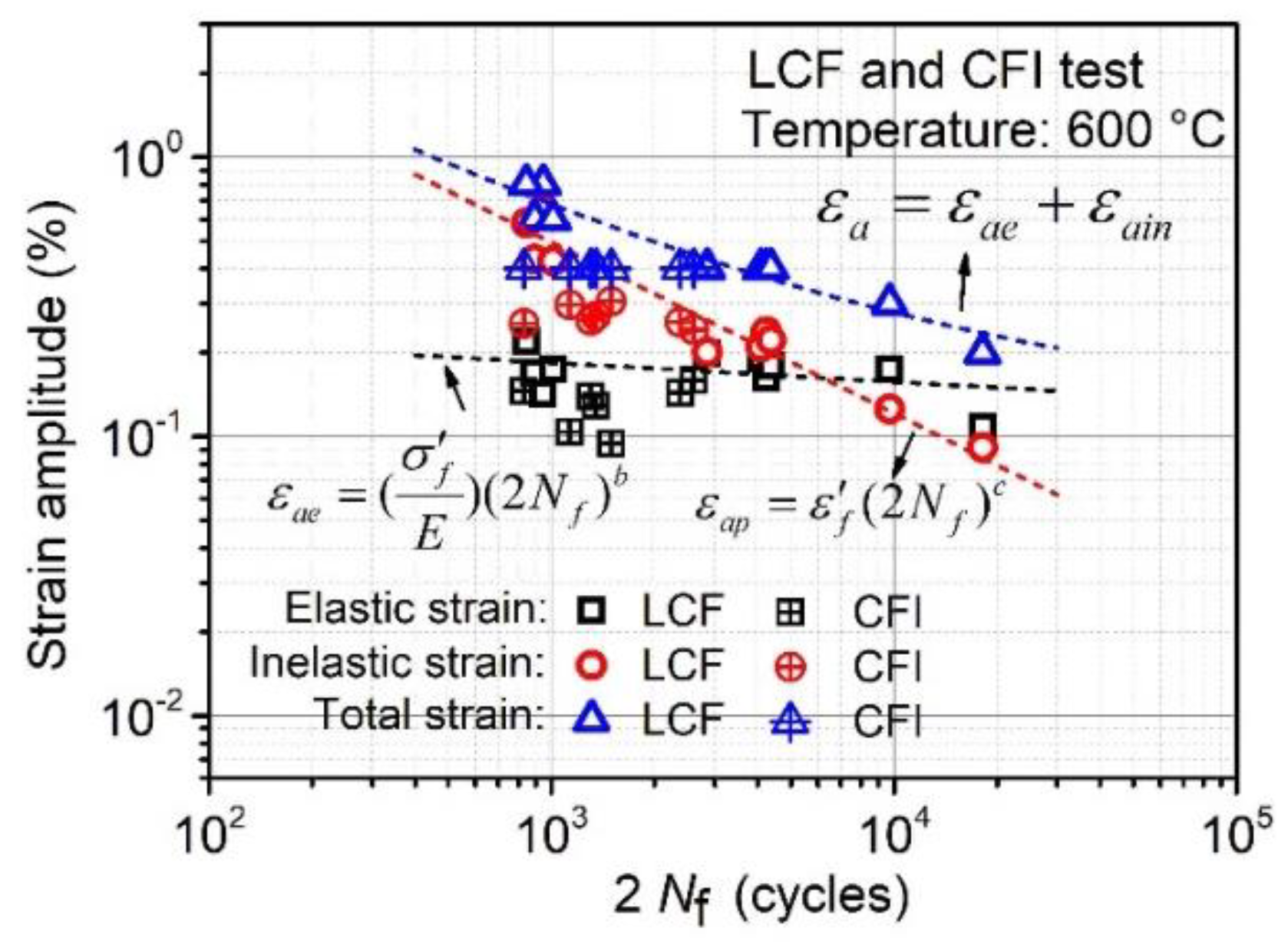
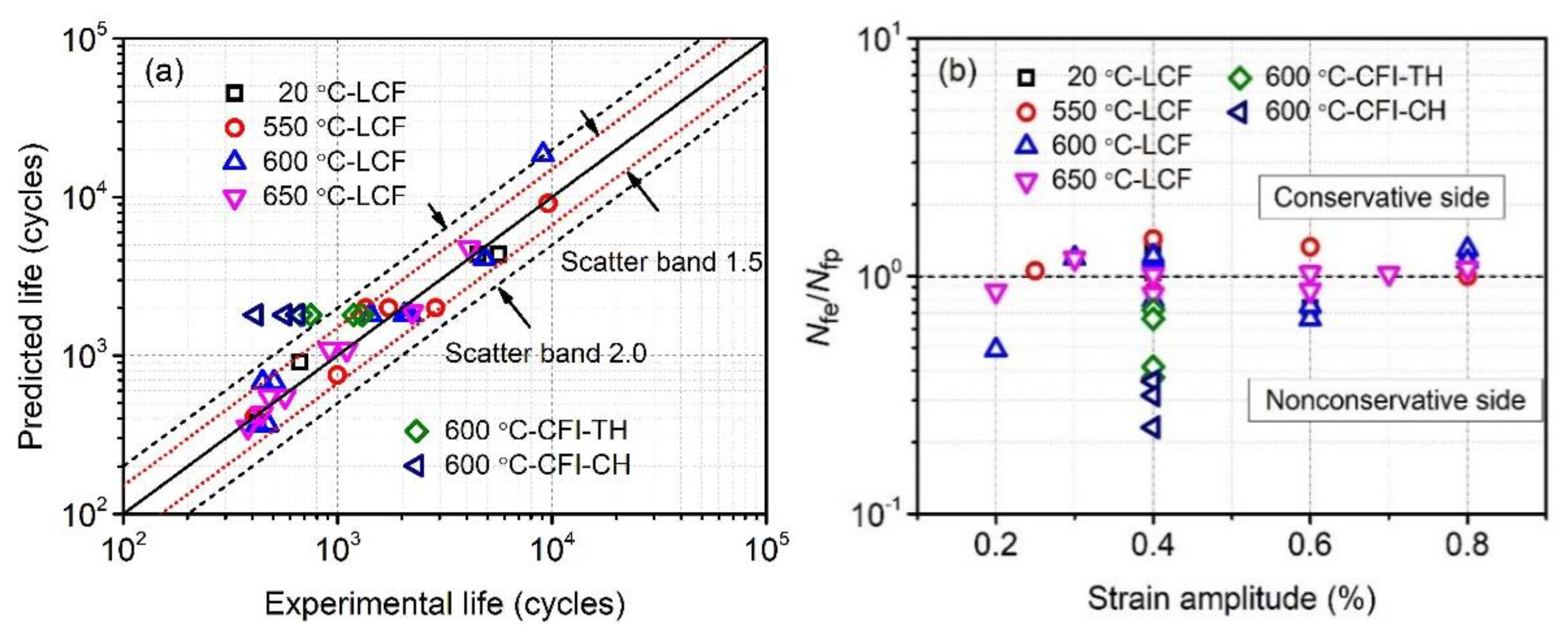
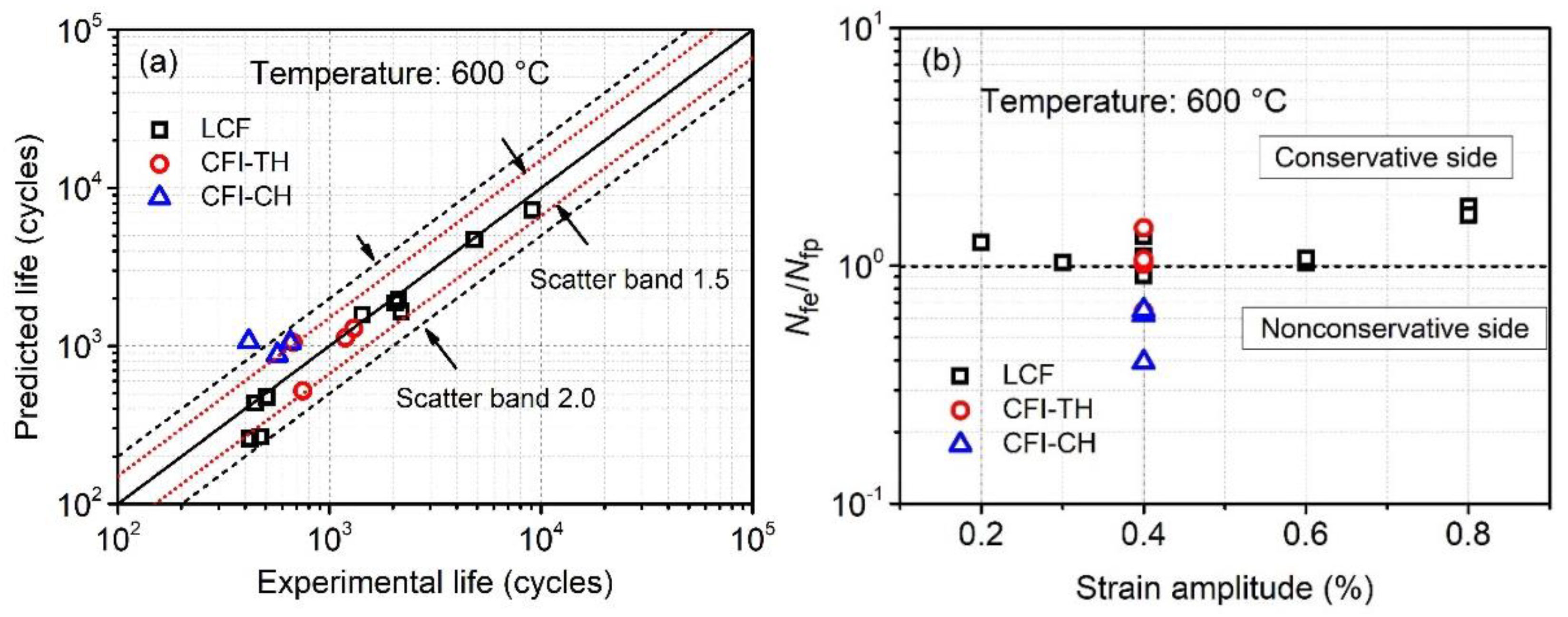

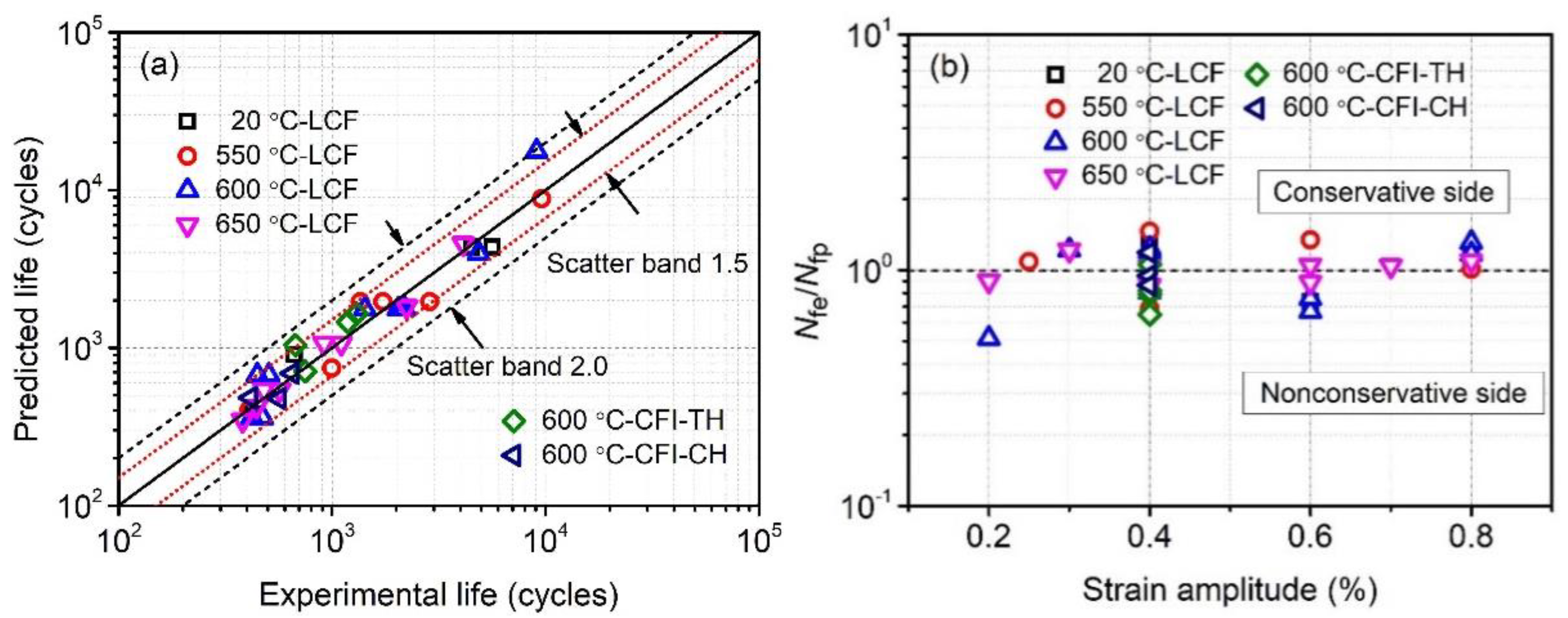
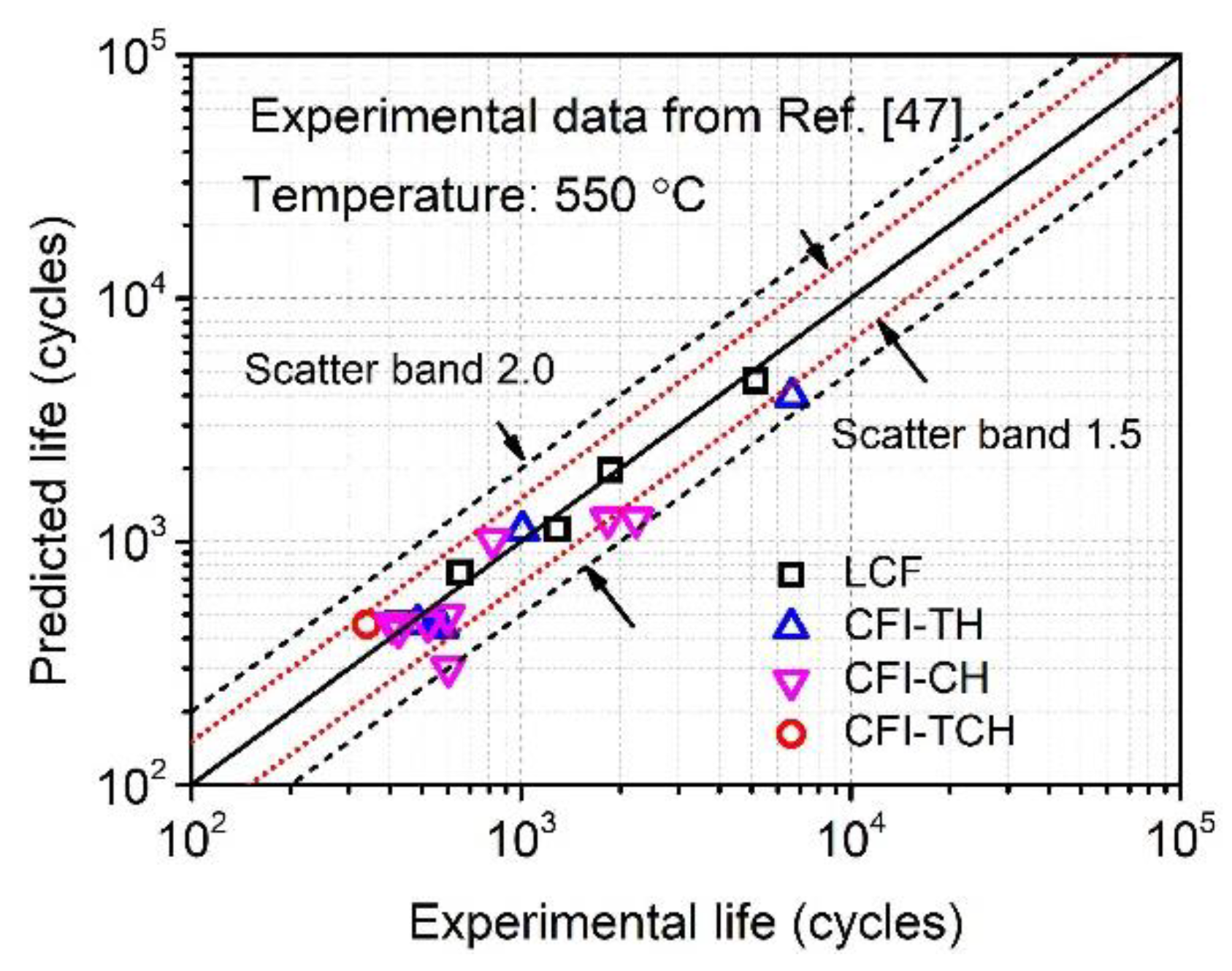
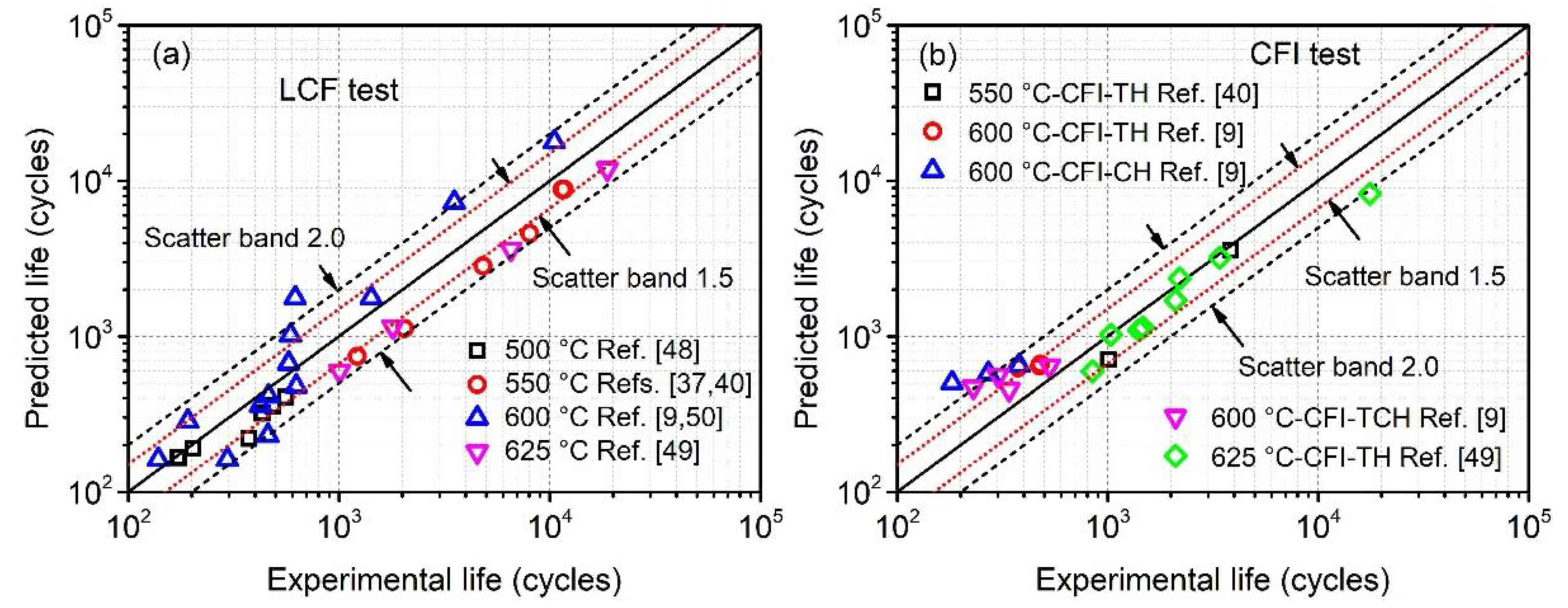
| Test Serial No. | Temperature (°C) | Strain Amplitude | TH Time, tt (min) | CH Time, tc (min) | Cycle Number of Life |
|---|---|---|---|---|---|
| PF20S04 | 20 | 0.4% | / | / | 5640/4513 |
| PF20S06 | 20 | 0.6% | / | / | 667 |
| PF20S08 | 20 | 0.8% | / | / | 423 |
| PF550S025 | 550 | 0.25% | / | / | 9599 |
| PF550S04 | 550 | 0.4% | / | / | 2874/1734/1356 |
| PF550S06 | 550 | 0.6% | / | / | 997 |
| PF550S08 | 550 | 0.8% | / | / | 410 |
| PF600S02 | 600 | 0.2% | / | / | 9078 |
| PF600S03 | 600 | 0.3% | / | / | 4861 |
| PF600S04 | 600 | 0.4% | / | / | 2045/2120/2186/1426 |
| CF600S04T01 | 600 | 0.4% | 1 | / | 1303 |
| CF600S04T03 | 600 | 0.4% | 3 | / | 1190 |
| CF600S04T10 | 600 | 0.4% | 10 | / | 675 |
| CF600S04T60 | 600 | 0.4% | 60 | / | 748 |
| CF600S04C01 | 600 | 0.4% | / | 1 | 652 |
| CF600S04C03 | 600 | 0.4% | / | 3 | 416 |
| CF600S04C10 | 600 | 0.4% | / | 10 | 567 |
| PF600S06 | 600 | 0.6% | / | / | 447/506 |
| PF600S08 | 600 | 0.8% | / | / | 473/422 |
| PF650S02 | 650 | 0.2% | / | / | 4124 |
| PF650S03 | 650 | 0.3% | / | / | 2232 |
| PF650S04 | 650 | 0.4% | / | / | 1102/918 |
| PF600S06 | 650 | 0.6% | / | / | 480/568 |
| PF600S07 | 650 | 0.7% | / | / | 444 |
| PF600S08 | 650 | 0.8% | / | / | 381 |
| Temperature | E (MPa) | σ’f | b | ε’f | c |
|---|---|---|---|---|---|
| 20 °C | 198,476 | 723 | −0.038 | 0.174 | −0.53 |
| 550 °C | 151,195 | 490 | −0.065 | 0.463 | −0.65 |
| 600 °C | 134,509 | 397 | −0.068 | 0.341 | −0.61 |
| 650 °C | 132,150 | 319 | −0.080 | 1.170 | −0.79 |
| Test No. | Temperature (°C) | Strain Rate (s−1) | Strain Amplitude | TH Time, tt (min) | CH Time, tc (min) | Cycle Number of Life |
|---|---|---|---|---|---|---|
| 1 | 550 | 0.001 | 0.3% | 1 | / | 6650 |
| 2 | 550 | 0.001 | 0.3% | / | 1 | 2233 |
| 3 | 550 | 0.001 | 0.3% | / | 10 | 1831 |
| 4 | 550 | 0.001 | 0.5% | 1 | / | 1010 |
| 5 | 550 | 0.001 | 0.5% | / | 1 | 821 |
| 6 | 550 | 0.001 | 0.5% | / | 10 | 599 |
| 7 | 550 | 0.001 | 0.5% | / | 60 | 602 |
| 8 | 550 | 0.001 | 0.75% | 1 | / | 550 |
| 9 | 550 | 0.001 | 0.75% | 10 | / | 485 |
| 10 | 550 | 0.001 | 0.75% | 60 | / | 573 |
| 11 | 550 | 0.001 | 0.75% | / | 1 | 521 |
| 12 | 550 | 0.001 | 0.75% | / | 10 | 406 |
| 13 | 550 | 0.001 | 0.75% | / | 60 | 426 |
| 14 | 550 | 0.001 | 0.75% | 10 | 10 | 340 |
| Parameters | τi (i = 1,2,3,4) | φi (i = 1,2,3,4) | ωi (i = 1,2,3,4) | γi (i = 1,2,3,4) |
|---|---|---|---|---|
| 29,970 | −27,638 | 5345 | 723 | |
| −9.82 | 7.18 | −1.39 | −0.038 | |
| 1075.33 | −802.14 | 149.89 | 0.174 | |
| −251.94 | 189.22 | −35.72 | −0.53 |
| Tensile Hold Condition | Compressive Hold Condition | ||||||
|---|---|---|---|---|---|---|---|
| αt | βt | gt | ht | αc | βc | gc | hc |
| 0.6 | 0.68 | 9.2 | 1185 | 0.73 | 0.12 | 19.3 | 1893 |
| Model | MCB | EB | FS | Modified MCB | |||||
|---|---|---|---|---|---|---|---|---|---|
| Ability | LCF | LCF, CFI | LCF, CFI | LCF, CFI | |||||
| Required Parameters | εa | Wp | εap | υt | υc | εa | tt | tc | T |
| Status | √ | × | × | √ | √ | √ | √ | √ | √ |
| Material | Temperature (°C) | Strain rate (s−1) | Type of Test | TH Time, tt (min) | CH Time, tc (min) | Ref. |
|---|---|---|---|---|---|---|
| Modified 9Cr-1Mo | 500, 600 | 0.001 | LCF | / | / | [48] |
| P92 | 625 | 0.002 | LCF, CFI | 0.5, 2, 5 | / | [49] |
| P91 | 600 | 0.001 | LCF | / | / | [50] |
| RAFM | 550 | 0.003 | LCF, CFI | 10 | / | [41] |
| P92 | 600 | 0.001 | LCF, CFI | 1, 5, 10 | 1, 5, 10 | [9] |
| P92 | 550 | 0.002 | LCF | / | / | [38] |
© 2019 by the authors. Licensee MDPI, Basel, Switzerland. This article is an open access article distributed under the terms and conditions of the Creative Commons Attribution (CC BY) license (http://creativecommons.org/licenses/by/4.0/).
Share and Cite
Wang, X.; Zhang, W.; Zhang, T.; Gong, J.; Abdel Wahab, M. A New Empirical Life Prediction Model for 9–12%Cr Steels under Low Cycle Fatigue and Creep Fatigue Interaction Loadings. Metals 2019, 9, 183. https://doi.org/10.3390/met9020183
Wang X, Zhang W, Zhang T, Gong J, Abdel Wahab M. A New Empirical Life Prediction Model for 9–12%Cr Steels under Low Cycle Fatigue and Creep Fatigue Interaction Loadings. Metals. 2019; 9(2):183. https://doi.org/10.3390/met9020183
Chicago/Turabian StyleWang, Xiaowei, Wei Zhang, Tianyu Zhang, Jianming Gong, and Magd Abdel Wahab. 2019. "A New Empirical Life Prediction Model for 9–12%Cr Steels under Low Cycle Fatigue and Creep Fatigue Interaction Loadings" Metals 9, no. 2: 183. https://doi.org/10.3390/met9020183
APA StyleWang, X., Zhang, W., Zhang, T., Gong, J., & Abdel Wahab, M. (2019). A New Empirical Life Prediction Model for 9–12%Cr Steels under Low Cycle Fatigue and Creep Fatigue Interaction Loadings. Metals, 9(2), 183. https://doi.org/10.3390/met9020183






